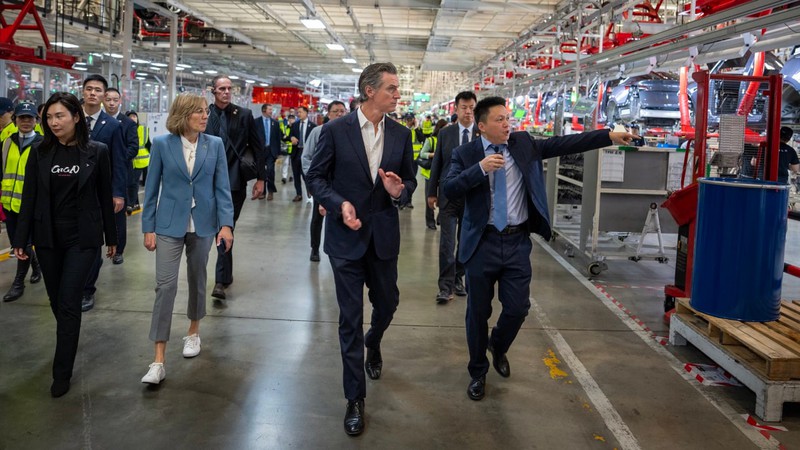A Tesla lobbyist, an LA-based environmental group, and Gov. Jerry Brown brought a rule minted in Sacramento to Beijing, and helped launch China’s EV industry.

Gov. Gavin Newsom tours a Chinese electric-car factory in October, 2023.
Almost ten years ago, as Elon Musk was negotiating with the Chinese government about building a Tesla factory in Shanghai, he and his lobbyists helped convince leaders there to adopt regulations based on California’s Zero Emissions Vehicle program. Tesla’s lobbyists had the help of a Los Angeles-based environmental group and then-Gov. Jerry Brown.
This is according to a March 27 New York Times article focused on threats to Tesla’s dominance in the EV market due to competition from Chinese automakers. The article, which contains information not previously reported, says the idea of bringing California-style clean-air laws to China came from the Innovation Center for Energy and Transportation (iCET), an environmental nonprofit with offices in Los Angeles and Beijing. It was iCET that approached a Tesla lobbyist “about working together on an emissions mandate in the country.”
After the Tesla lobbyists visited officials in three Chinese cities, Feng An, iCET’s executive director, took two groups of Chinese city officials to visit Tesla’s office in California.
California’s mandate program allows manufacturers that build clean cars to sell emissions credits to automakers that do not meet pollution targets. Since launching its first car, the Roadster, in 2008, Tesla has earned vast sums under the state’s emissions mandate. According to Gov. Gavin Newsom’s office, those credits were worth $3.71 billion by late 2023.
China did in fact put those mandates in place. Tesla, of course, built its factory and helped launch the Chinese electric-car industry that is now racing up his heels. And in the past ten years, China’s air pollution—which was once so bad that it wafted across the ocean and contributed to LA’s bad air—has improved dramatically.
A Brief History of China-California Clean-Tech Cooperation
Tesla’s recent appearance in the story of how California helped China fix its once-crippling smog problem is the latest chapter in a tale that dates back at least to 2005. That’s when Arnold Schwartzennegger became the first California governor to conduct a trade mission to China, where he pitched the clean-energy technologies being developed in Silicon Valley and elsewhere in the state. (At that time, the Richmond, CA-based SunPower was the world’s leading solar power company, selling panels designed in California and built in Chinese factories.)
In 2012, the California Air Resources Board (CARB), which had been established by Gov. Ronald Reagan to protect Californians from toxic air pollution, mandated that one in seven cars sold in the state by 2025 be an ultra-low- and zero-emission vehicle. A few months later, Jerry Brown guest-starred at an event where Elon Musk rolled out the Tesla Model X. Later that year, Brown traveled to China, primarily to push for cooperation on clean-technology initiatives, according to the Los Angeles Times.
“Brown plans to sign pacts forging government research partnerships and limiting Chinese greenhouse gas emissions,” the Times reported. “He’ll announce deals involving California clean-technology companies — electric vehicle makers, a firm that converts trash to electricity — and reinforce his mantra that good environmental policy is good economics.”
On that trip, Brown hammered out the agreement that established policy exchanges between CARB and Beijing officials. That, likely thanks to the added inducement of a Tesla factory within its borders, resulted in China’s “Designed-in-California” EV mandate.
An International Environmental Victory
Yunshi Wang, director of the China Center for Energy and Transportation at the UC Davis Institute of Transportation Studies, told Politico’s Blanca Begert last October that China’s adoption of California’s zero-emissions vehicle mandate drastically reduced air pollution in Beijing. Wang said China has essentially caught up with the Golden State when it comes to clean transportation.
Over the past decade, the diesel bus fleets that once pumped dirty exhaust that clogged every Chinese city have been mostly replaced with electric vehicles.
“On the zero-emission vehicle side, the transportation side, China has done pretty well,” he said. “There’s nothing there California could share with China anymore as a country.”
And yet California continues to influence both the economy and policy in China. Wang’s comment came as Gov. Gavin Newsom visited China to continue the tradition of governors using the office “to leverage California’s economic and cultural might to bridge geopolitical gaps on climate change,” Begert writes.
“China is a third of the world’s emissions,” Newsom told reporters…. “Between the United States and China it’s about 42 percent. If the U.S. and China do not collaborate and cooperate on the issue of climate, we’re in real trouble.”
Brown, who now leads the California-China Climate Institute at UC Berkeley, told Poliotico at the time that Newsom’s visit could help California maintain good relations with China.
“This is a very dangerous and fraught time,” Brown said. “And so any move that is in a positive vein is a big, big positive. I would frame the Newsom visit in that context.”
Meanwhile, China’s EV industry—virtually nonexistent when Elon Musk first went there—now accounts for nearly 60 percent of sales worldwide. Last month, following news that Tesla's sales lagged behind Chinese competitors, the company’s stock price fell, and Musk was displaced as the richest person in the U.S..
Long form articles which explain how something works, or provide context or background information about a current issue or topic.